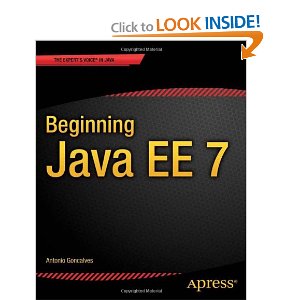to be or not to be? Java EE Book
Good afternoon, habrovchani.
Our publisher asked whether it was worth making a book on Java EE, so we decided to ask the opinion of experts. Please leave your comments in the comments.
Recently there was such a wonderful book - Beginning Java EE 7 .

Java Enterprise Edition (Java EE) remains one of the leading technologies and platforms based on Java.
The book, which we want to talk about, is a logical step-by-step tutorial in which many specifications and reference implementations of Java EE 7 are described in detail. Working with them is demonstrated with practical examples. This fundamental book also uses the latest version of the GlassFish tool used to deploy and administer sample code.
The book is written by a leading expert in processing requests for the Java EE specification, a member of the supervisory board of the Java Community Process (JCP). In it you will find the most valuable information presented from the point of view of a Java technology expert for enterprises.
')
What you learn:
Who is this book for?
This book is aimed at programmers working with Java or Spring, who have little experience with Java EE or have not yet come across this platform. Architects will find in the book interesting information about building multi-tier applications in Java EE.
Content:
1. Java EE 7 Ecosystem
2. Embedding Context and Dependencies
3. Validation of components
4. Java Persistence API
5. Object-relational mapping
6. Permanent Object Management
7. Corporate Java Components
8. Callbacks, timer and authorization
9. Interceptors and transactions
10. JavaServer Faces
11. Processing and navigation
12. XML and JSON
13. Work with messages
14. SOAP Web Services
15. RESTful web service
Our publisher asked whether it was worth making a book on Java EE, so we decided to ask the opinion of experts. Please leave your comments in the comments.
Recently there was such a wonderful book - Beginning Java EE 7 .

Annotation:
Java Enterprise Edition (Java EE) remains one of the leading technologies and platforms based on Java.
The book, which we want to talk about, is a logical step-by-step tutorial in which many specifications and reference implementations of Java EE 7 are described in detail. Working with them is demonstrated with practical examples. This fundamental book also uses the latest version of the GlassFish tool used to deploy and administer sample code.
The book is written by a leading expert in processing requests for the Java EE specification, a member of the supervisory board of the Java Community Process (JCP). In it you will find the most valuable information presented from the point of view of a Java technology expert for enterprises.
')
What you learn:
- Get to know the latest version of the Java EE platform.
- Explore and learn how to use the EJB and JPA APIs — from entity components, session components to message-driven components, and more.
- Discover APIs for web-level development — in particular, JSF, Facelet, and Expression Language.
- Learn how to handle SOAP and RESTful web services, as well as other services available in the latest version of Java EE.
- Create dynamic user interfaces for enterprise and transactional Java applications.
Who is this book for?
This book is aimed at programmers working with Java or Spring, who have little experience with Java EE or have not yet come across this platform. Architects will find in the book interesting information about building multi-tier applications in Java EE.
Content:
1. Java EE 7 Ecosystem
2. Embedding Context and Dependencies
3. Validation of components
4. Java Persistence API
5. Object-relational mapping
6. Permanent Object Management
7. Corporate Java Components
8. Callbacks, timer and authorization
9. Interceptors and transactions
10. JavaServer Faces
11. Processing and navigation
12. XML and JSON
13. Work with messages
14. SOAP Web Services
15. RESTful web service
Source: https://habr.com/ru/post/188464/
All Articles